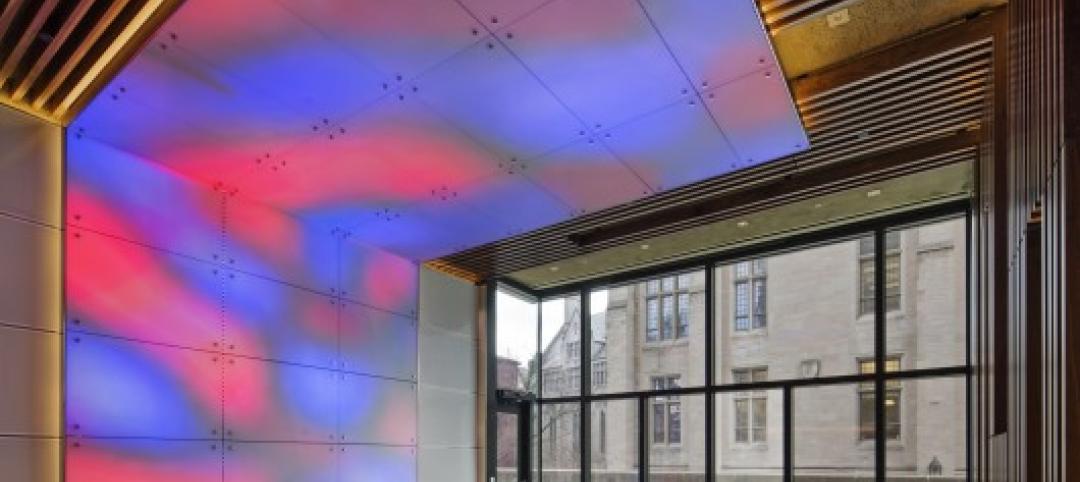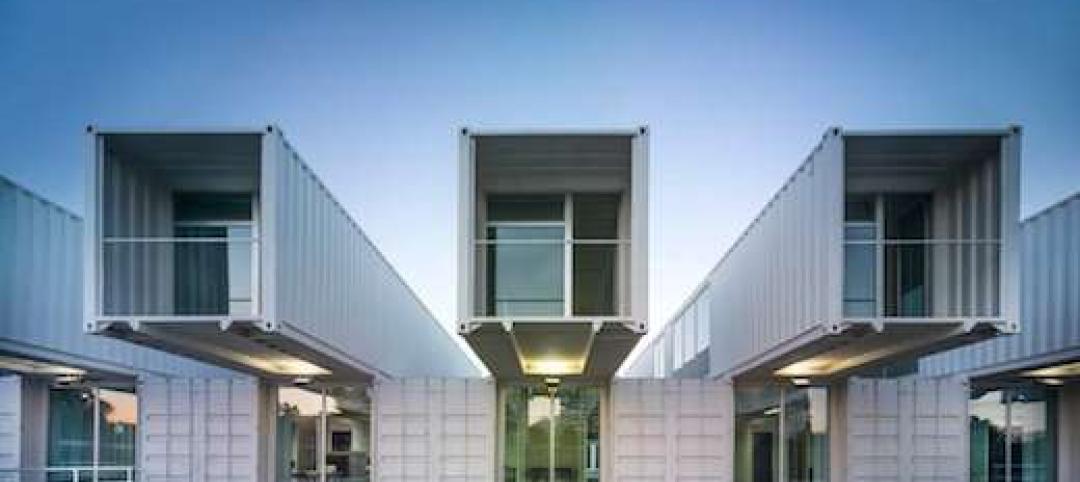While exposed ceilings in office interiors lend a spacious, open feel, this trendy architectural feature has created a new challenge: finding a viable return air path. Plenum ceilings use the area between the dropped ceiling and the floor slab above as a return air path, but when these dropped ceilings are removed, the plenum area is reduced and can restrict the flow of return air.
Since air will always take the path of least resistance, removing all or part of the dropped ceiling and reducing the plenum area can create unique pressure and return airflow patterns, which can vary on a daily, weekly, and seasonal basis, and are usually at their worst when the air handling system is economizer mode (taking in larger quantities of outside air).
Fortunately, with some sound engineering directive, it is often possible to preserve the exposed ceiling while promoting desirable return airflow patterns. Boiled down into five guiding principles, the following can be successfully applied to evaluate and often overcome the exposed ceiling challenge.
1. Better to oversize, not undersize, return air transfer openings.
While architects generally want return air openings to be as small as possible from an aesthetic point of view, engineers strongly recommend generously sizing them in order to encourage the air to properly flow through. Because air will take the path of least resistance to find its way back to the central return air duct and then to the air handling unit, if these openings are undersized, air may flow elsewhere.
One of the most common problems occurs when entry doors to a space are opened and air rushes through these doors. In severe conditions, the doors may even stay partially open due to the strong airflow. A good rule of thumb is to size return air transfer openings so that the air flows through at a low velocity of roughly 250 feet per minute.
2. Select areas of dropped ceilings are often necessary.
In addition to the potentially undesirable aesthetics associated with larger return air openings, exposed ceilings can pose significant acoustical challenges as well. Whether it’s a fan-powered box, duct leakage from improperly sealed ductwork or the sound of air traveling back to the main return, large, open ceilings provide no barrier to attenuate sound.
One potential solution could be dropping in a few architectural clouds, particularly in places where the main return air openings are located (typically near building “core” areas – i.e. elevator banks). For spaces that are particularly challenged acoustically, add sides on the clouds to create a more effective acoustical buffer while still preserving the open plenum look and hiding unsightly mechanical equipment.
3. Avoid returning air through adjacent tenant spaces.
In some buildings with dropped ceilings, return air was designed to run above multiple tenant spaces to find its way back to the central return opening. However, when two tenants with open ceilings are located next to one another, running return air from one tenant space through another is not only undesirable (your neighbor won’t appreciate the smell of your burnt popcorn), but in all likelihood does not meet local code requirements either.
In order to mitigate this, the engineering team should take a holistic look at the building design to figure out exactly how the air is flowing so that a proper return air path can be created for all tenant spaces.
4. Carefully survey the core area ceilings to identify ductwork or other items impeding the free flow of re-turn air.
While generously sizing the return plenum air opening can be an effective way to support optimal air-flow, if the core space is packed with ductwork and/or piping, and thus reducing the area of the return air path, it can create insurmountable challenges. Even if return air openings to the plenum are generously sized, a congested return air plenum will restrict airflow and may still result in undesirable airflow patterns as noted in Item 1.
McGuire was brought in to help with corrections on a recent project: a new tenant occupying two floors inside a Midwest office building added a stairwell to connect their floors. The upper floor’s return air plenum was very congested, which had never been an issue until the new stair was added. The stairwell introduced a new path for the air to flow, creating significant draft issues in the lower floor’s reception area.
In cases such as these, creative engineering must be employed to provide another more appropriate path for the airflow.
5. Every building is different and main air system imbalance or congested corridor ceilings may be difficult or impossible to overcome.
Yet another potential difficulty with exposed ceilings comes into play when a high percentage of outside air is desired for natural ventilation. For example, on a 55°F to 60°F day, a building’s air handling units may run in economizer mode to bring in larger amounts of outside air for “free” cooling. Of course, this same air needs to be returned and exhausted. If an adequate return air path isn’t properly designed—perhaps due to congested ceilings or inadequate transfer openings – the return air problems can often be exacerbated when the building systems are in economizer mode. In such a situation, the building may decide to limit the percentage of outside air intake. While the optimal solution may be to significantly change the layout and re-engineer the space, such an approach may be cost prohibitive.
Careful Consideration
When moving into an existing building and redesigning your space with an open plenum, all HVAC idiosyncrasies must be carefully evaluated. While airflow in an existing tenant space with closed ceilings may be working just fine, once the ceiling is opened up, issues can arise. If any significant issues with regards to the main building air system are discovered, an open ceiling may simply not work, unless the building owner is willing to make the required changes to support a proper return air flow design.
When considering an exposed ceiling for a tenant build-out, it’s important to confer with the facility manager about air patterns, in addition to speaking with other tenants in the building who may have exposed ceilings to learn more about how the air is flowing through those particular spaces.
Armed with this information, the building team can better determine exactly how to design the desired open ceiling space and air plenum to support the architect’s plan, both aesthetically and functionally – maintaining optimal comfort for all occupants.
About the Author
Bill Stangeland is President and Partner with McGuire Engineers. He has more than 30 years of experience in HVAC and plumbing systems design. He is responsible for overall quality control of the firm's business, fostering client satisfaction, and the mentoring and development of new and existing staff. Stangeland's extensive experience encompasses commercial projects, branch banks, churches, auditoriums, medical office buildings, and out-patient surgical suites. He maintains strong client relationships by delivering successful projects that meet each client's unique goals and needs.
Related Stories
| Jun 10, 2014
New York's first-ever public housing for visually-impaired begins upgrade
Selis Manor is the first government-funded residence for the vision-impaired and disabled in New York City. MAP’s design eases crowding, increases security, and separates residents and visitors.
| Jun 9, 2014
6 design strategies for integrating living and learning on campus
Higher education is rapidly evolving. As we use planning and design to help our clients navigate major shifts in culture, technology, and funding, it is essential to focus on strategies that help foster an education that is relevant after graduation. One way to promote relevance is to strengthen the bond between academic disciplines and the campus residential life experience.
| Jun 9, 2014
Green Building Initiative launches Green Globes for Sustainable Interiors program
The new program focuses exclusively on the sustainable design and construction of interior spaces in nonresidential buildings and can be pursued by both building owners and individual lessees of commercial spaces.
| Jun 9, 2014
10 projects named 2014 AIA Small Project Award winners
Yale's funky new Ground café and a pavilion made from 53,780 recycled plastic bottles are among the nation's best new small projects.
| Jun 9, 2014
Eli Broad museum files $19.8 million lawsuit over delays
The museum, meant to hold Eli and Edythe Borad's collection of contemporary art, is suing the German company Seele for what the museum describes as delays in the creation of building blocks for its façade.
| Jun 8, 2014
What’s the word of the day? It’s all about ‘resiliency’
Just for the sake of argument, let’s put aside the rhetoric about climate change—whether it’s actually happening, whether it’s a result of manmade activity—and agree that we are experiencing some pretty dramatic weather events that are having huge impacts on populations here in the U.S. and worldwide.
Smart Buildings | Jun 8, 2014
Big Data: How one city took control of its facility assets with data
Over the past few years, Buffalo has developed a cutting-edge facility management program to ensure it's utilizing its facilities and operations as efficiently, effectively, and sustainably as possible.
| Jun 6, 2014
Must see: Can a floating city offset urban population growth in China?
AT Design Office has proposed a design for a floating city to offset increasing urban populations in China. To create the new city, a 10-square kilometer island would be made out of prefab blocks.
| Jun 6, 2014
KPF, Kevin Roche unveil design for 51-story Hudson Yards tower in NYC [slideshow]
Related Companies and Oxford Properties Group are teaming to develop Fifty Five Hudson Yards, the latest addition to the commercial office tower collection in the 28-acre Hudson Yards development—the largest private real estate development in the history of the U.S.
| Jun 6, 2014
Shipping container ship terminal completed in Spain
In Seville, Spain, architectural firms Hombre de Piedra and Buró4 have designed and completed a cruise ship terminal out of used shipping containers.















